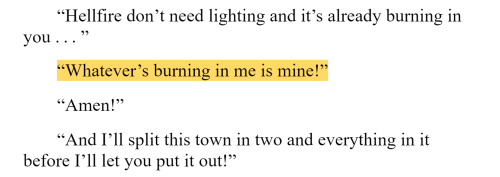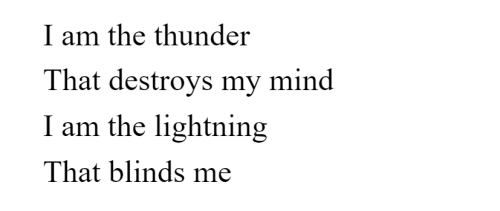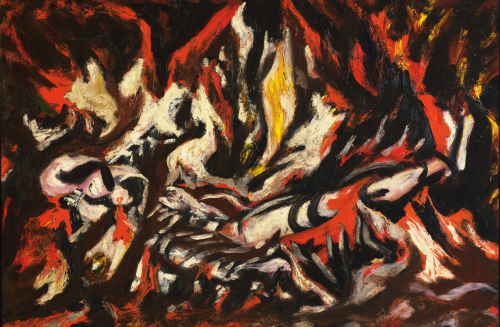Curate, connect, and discover
Excerpts From Text - Blog Posts
In other words, Cassandra is not just a translator, she is also an embodiment of the very function of translation: her prophetic speech often appears to be suspended between languages, like Benjamin's translator who operates in the realm of 'pure language' that is beyond any single linguistic code. Cassandra takes and reformulates and incomprehensible message from the future and becomes incomprehensible in the process, (re)producing a message in such a way that it demands a second, or third or fourth translation. Sometimes she descends from a trance-like state of prophecy to initiate the next link in the chain of interpretations herself, reframing her own message in more prosaic language, only to find that this speech too is received with confusion. Her utterance is always both a target and source text at the same time. The proliferation of translation acts within her single body evokes a kind of never-ending self-translation; like the self-translator, Cassandra suffers a splitting of the self, one part of which is committed to the spirit of the original composition, while the other struggles to reframe it for a new audience that can never grasp the meaning of the original.
Emily Pillinger, Cassandra and the Poetics of Prophecy in Greek and Latin Literature
“It’s not ‘natural’ to speak well, eloquently, in an interesting articulate way. People living in groups, families, communes say little–have few verbal means. Eloquence–thinking in words–is a byproduct of solitude, deracination, a heightened painful individuality.”
— Susan Sontag, As Consciousness Is Harnessed to Flesh (via the-book-diaries)
“Take my heart and hurl its fragments to the moon, the trees, the beasts, in the air, the dark, the waters, so that nothing returns to me ever again.”
— Anna de Noailles, tr. by Jean Morris, from Poems; “Ariadne’s Lament,”
In contemporary (post-modern) horror, the threat is “not simply among us, but rather part of us, caused by us.” Institutions (like the church and the military) that were once successful in containing the monster and restoring order are at best ineffectual (there is often a lack of closure) and at worst responsible for the monstrous. Contemporary horror also tends to collapse the categories of normal bodies and monstrous bodies; it is said to dispense with the binary opposition of us and them, and to resist the portrayal of the monster as a completely alien Other, characteristic of such 1950s films as The Thing (from Another World) (1951), Them! (1954), and The Blob (1958). This tendency to give the monster a familiar face (the monster is not simply among us, but possibly is us) is tied, in postmodern horror, to the focus on the body as site of the monstrous.
–Lianne McLarty, “Beyond the Veil of the Flesh”: Cronenberg and the Disembodiment of Horror, from The Dread of Difference: Gender and the Horror Film
A cobra is dangerous only when it is coiled, ready to strike in an instant; when its body is completely erect it is quite harmless. Similarly, the kundalini is dangerous only in its form of the diffuse life energies, which fuel the unillumined person's hankering for sensory and sensual experiences, entangling him or her ever more in worldly karma. When the serpent power is erect, however, it is not poisonous but a source of ambrosia, because it is erect only when it has entered the central pathway leading to liberation and bliss. As Jayaratha explains in his commentary on the Tantra-Aloka (chapter 5, p. 358), when one strikes a serpent it draws itself up and becomes stiff like a rod. Similarly, through the process of "churning" the kundalini stretches upward into the perpendicular pathway of the sushumna, reaching with its head for the topmost psychoenergetic center. Georg Feuerstein, Tantra: The Path of Ecstasy, Chapter 11: Awakening the Serpent Power.
As with most female horror fans, people love to ask me what it is I get out of horror. I give them the stock answers: catharsis, empowerment, escapism and so on. Less easy to explain is the fact that I gravitate toward films that devastate and unravel me completely – a good horror film will more often make me cry than make me shudder.
Kier-La Janisse, House of Psychotic Women
“The manifold self-contradictions in Greek ideas and phrasing about death are not errors. They are styles of imagining the unimaginable, and are responsive both to personal needs and to old conventions. The same conflicts surge up in many cultures. They are necessary ambiguities in a realm of thinking where thinking cannot really be done, and where there is no experience.”
— Emily Vermeule, “Immortals are Mortal, Mortals Immortal,” Aspects of Death in Early Greek Art and Poetry
“Dionysus is powerful because he is a god; but in myth, at least, the god conceals his divinity in order to impress his presence all the more forcefully on mortals. In his mythical epiphanies, he exercises his destructive power from a position of apparent weakness and inferiority… the punishment he inflicts is often indirect, deceptive and designed to hide his presence and downplay his power; unlike Apollo or Artemis, he does not kill his victims through direct divine intervention, but relies on those self-destructive drives within their human nature that case madness, self-mutilation or transformation.”
— Albert Henrichs, “He Has a God in Him”: Human and Divine in the Modern Perception of Dionysus
“Medea is very much concerned with the problem of woman’s place in human society […] Euripides is concerned in this play not with progress or reform but (as in the Hippolytus and the Bacchae) with the eruption in tragic violence of forces in human nature which have been repressed and scorned, which in their long-delayed breakout exact a monstrous revenge. The Medea is not about woman’s rights; it is about woman’s wrongs, those done to her and by her.”
— Knox, B. (1979). The Medea of Euripides, from Word and action: essays on the ancient theater. Baltimore: Johns Hopkins University Press, pp.295-322.








toni morrison, sula // stephanie peters, fire // seneca, medea (trans. a.j. boyle) // david mcconochie, medea // peter russell, night the first // stephanie peters, roaring flame // hozier, arsonist’s lullabye // jackson pollock, the flame

"'Will Not Let Die': Debilitation and Inhuman Biopolitics in Palestine" in The Right to Maim, Jasbir Puar

"'Will Not Let Die': Debilitation and Inhuman Biopolitics in Palestine" in The Right to Maim, Jasbir Puar
One of the oldest goddesses in the historical record is Inanna of Mesopotamia, who was referred to, among other honorifics, as “She who makes a woman into a man, she who makes a man into a woman.” The power to alter such fundamental categories was evidence of her divine power. Inanna was served by at least half a dozen different types of transgendered priests, and one of her festivals apparently included a public celebration in which men and women exchanged garments. The memory of a liminal third-gender status has been lost, not only in countries dominated by Christian ideology, but also in many circles dedicated to the modern revival of goddess worship. Images of the divine feminine tend to appear alone, in Dianic rites, surrounded only by other women, or the goddess is represented with a male consort, often one with horns and an erect phallus. But it is equally valid to see her as a fag hag and a tranny chaser, attended by men who have sex with other men and people who are, in modern terms, transgendered or intersexed.
— Speaking Sex to Power: The Politics of Queer Sex by Patrick Califia
But our notebooks give us away, for however dutifully we record what we see around us, the common denominator of all we see is always, transparently, shamelessly, the implacable “I.” We are not talking here about the kind of notebook that is patently for public consumption, a structural conceit for binding together a series of graceful pensées; we are talking about something private, about bits of the mind’s string too short to use, an indiscriminate and erratic assemblage with meaning only for its maker. And sometimes even the maker has difficulty with the meaning.
Joan Didion, from On Keeping A Notebook in: Slouching Towards Bethlehem
“The story of Hades and Persephone, frequently retold and referenced, became a motif for marrying death… In addition, wedding and funeral rites, in which women played a crucial role, had many similarities. The bride and corpse were washed, dressed, anointed, and either veiled (bride) or shrouded (corpse). Both journeyed to a new home, led by a procession of family and friends carrying torches, with song and dance, blessings, gifts, and a feast. Antigone makes those connections explicit in marrying Antigone to death in her last scene instead of to Kreon’s son, her betrothed.”
— Diane J. Rayor, excerpt from the “Introduction” to Antigone
“The so-called ‘mystery cults’ were a handful of marginal Eastern Mediterranean cults which achieved popularity throughout the Roman empire and were distinguished as a unique religious phenomenon by the Belgian archaeologist and philologist Franz Cumont in his 1906 book Oriental Religions in Roman Paganism. This modern label of ‘mystery cults’ has now long been used as a blanket designation to cover the cults held in honour of Mithra, Attis and Cybele, Isis and Osiris, Demeter and Persephone, Orpheus and Bacchus/ Dionysus, and the Samothracian Kabeiroi, among countless other minor and local groups who will never be remembered. Each of these cults (with perhaps the exception of Mithraism) revolved around the dramatic and ecstatic veneration of “dying-and-rising-gods,” a title formulated by the founding father of comparative religion, James G. Frazer, and subsequently developed by British and Scandinavian members of the Myth-and-Ritual School. These so-called “Cambridge Ritualists,” held to the notion that myths do not stand on their own, but are born out of ritual. This theory, of course, is heavily disputed; but the alternative view is equally enlightening: that myth and ritual evolve along parallel lines, without one developing strictly out from the other. The ‘Divine Bridegroom’ is similarly a name I use for these dying mystery gods. For the most part, the mystery religions were sanctuary based, taking place in a telestrion (initiation chambers), caves, or mountain groves, and their members were organized by a structure of hierarchical degrees of initiation. The “mysteries” themselves generally entailed dramatic experiences conveyed via esoteric initiation ceremonies that were reflections of annual agricultural and astrological cycles. Already the mainstream view of old-school ethnologists believed in the notion that the mysteries were survivals of ancient “rites of passage,” especially by Mircea Eliade and Angelo Brelich. Many believed that the origin of the mysteries should be sought in some stage of primitive agricultural development, and it is in illo tempore - into that mythic dream time - to which I wish to return throughout this book.”
— Dan Attrell - Shamanism and the Mysteries: A Brief History of the Cult of Ecstasy










